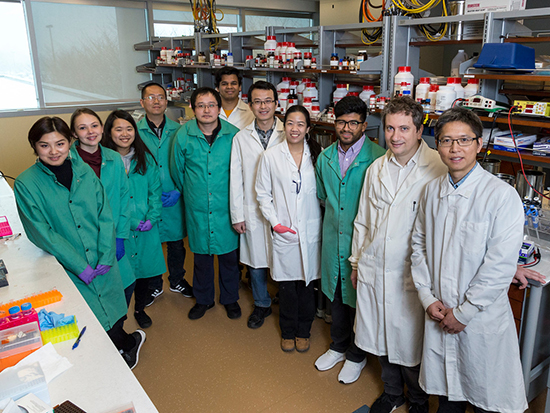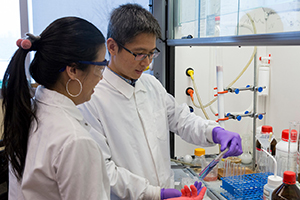The Hunt to End Disease
 |
|
Chemists Max Royzen (one from right) and Jia Sheng (far right) have received federal grants in total of just under $900,000. (Photo by Brian Busher) |
ALBANY, N.Y. (March 8, 2018) – UAlbany chemists Max Royzen and Jia Sheng want to better understand how our body’s ribonucleic acid (RNA) can help fight some of the most challenging human diseases such as cancer, Alzheimer’s disease and HIV.
New funding from the National Science Foundation (NSF) will ensure they continue laying the groundwork.
Royzen and Sheng, affiliates of The RNA Institute, have received NSF grants in total of just under $900,000. The funding will support their ongoing exploratory research projects for the next three years.
For Royzen, the award is supporting his lab’s development of a chromatography-free synthesis and purification of RNA that would be applicable to any RNA strand regardless of its size. It represents the first step to the introduction of site-positioned RNA-based therapeutics, which could limit toxic damage on a patient’s body during treatment.
Sheng’s award, his lab’s first, is supporting efforts in understanding why chemical modifications are necessary for RNAs to function normally. This research is not only significant to fundamental biology, but also to the development of RNA-based drug therapeutics. In addition, the modifications have been regarded as the chemical fossils left from the original stages of life and can offer evolutionary clues.
The projects both fit into The RNA Institute’s mission of targeting DNAs molecular cousin for drug discovery and diagnostics.
‘The NSF awards to Drs. Royzen and Sheng are well deserved, as they on the cutting-edge of RNA research,” said Thomas Begley, interim director of The RNA Institute. “These exciting projects will lead to important advancements and will provide exciting training opportunities for students. We are proud to have both scientists as members of our RNA Institute, and congratulate them on their accomplishments.”
 |
|
Phensinee Haruehanroengra, a Ph.D. chemistry student, works in the lab of assistant professor Jia Sheng. (Photo by Brian Busher)
|
Engaging Students:
Providing education and research opportunities to students is a key component to all NSF-funded research.
Both chemists are offering lab positions to undergraduate and graduate students through their grants. Royzen is also inviting high school teachers and students from the Capital Region to collaborate on his project.
“It is important that we offer opportunities to train students who are interested in our research,” Royzen said. “They are the next generation of RNA scientists who will some day advance the work being done at our institute.”
“For RNA to remain a viable tool for the treatment of human diseases, it’s critical that we proactively generate student interest in our work,” Sheng added.
You can learn more about The RNA Institute and its mission here.
![]() For more news, subscribe to UAlbany's RSS headline feeds
For more news, subscribe to UAlbany's RSS headline feeds
A comprehensive public research university, the University at Albany-SUNY offers more than 120 undergraduate majors and minors and 125 master's, doctoral and graduate certificate programs. UAlbany is a leader among all New York State colleges and universities in such diverse fields as atmospheric and environmental sciences, business, education, public health,health sciences, criminal justice, emergency preparedness, engineering and applied sciences, informatics, public administration, social welfare and sociology, taught by an extensive roster of faculty experts. It also offers expanded academic and research opportunities for students through an affiliation with Albany Law School. With a curriculum enhanced by 600 study-abroad opportunities, UAlbany launches great careers.


